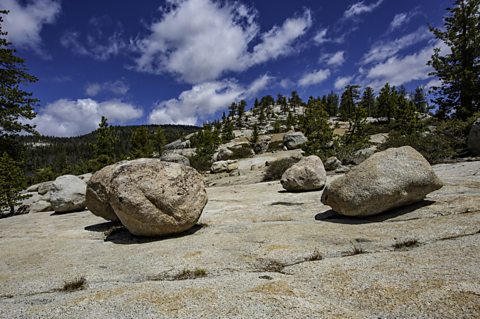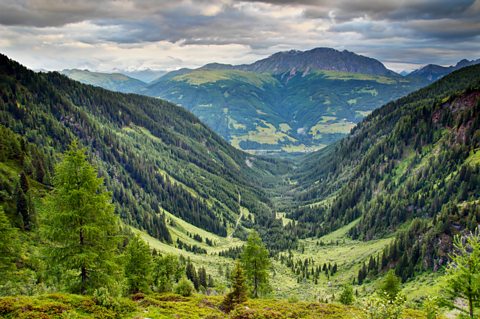What do you know?
What is a glacier?
A glacier is a slowly moving mass of ice.
Key points
- Glaciers are large masses of frozen ice that move slowly downhill.
- As glaciers move, they wear away the surrounding land through erosion.
- Glaciers sometimes transport material over long distances before eventually depositing it.
What is a glacier?
Glaciers are large bodies of ice that cover about 10% of the Earth’s surface in cold regions such as Antarctica and the Arctic as well as in high mountain ranges such as The Alps, Andes and Himalayas.
A short film that shows the processes of glaciation and how glaciers shape and impact the landscape
Glaciation refers to the formation of huge bodies of ice called glaciers, and the way they erode and change the landscape as they move.
Glaciers are made of densely packed snow that's fallen in the same place over years and years.
Each fresh fall of snow adds to the weight, crushing the layers of snow below, turning it into ice.
A glacier is a bit like a very, very slow moving river and just like a river, it changes the landscape around it over time - a very, very long time.
As they move along, glaciers can pick up pretty much anything in their path, from pebbles to massive boulders. It all depends on how big the glacier is and how fast it is moving.
As glacial ice moves very slowly downhill, pieces of rock and gravel get stuck between the ice and the land, forming a coarse surface, similar to the sand on sandpaper. These rocks grind together, creating tiny grains of dust, called rock flour.
Some glaciers flow all the way to the sea and when they get there, pieces of the glacier can break off and form icebergs.
Thousands of years ago, glaciers were a feature of the landscape here in Britain and they left behind many U-shaped valleys that can be found in places like the Lake District in England and the Highlands of Scotland.
Today, glaciers store about three quarters of the Earth's fresh water, more than all the rivers and lakes put together.
Climate change is having a real impact on them. Even in the Antarctic, the coldest place on Earth, there is increasing evidence that rising temperatures are causing glaciers to melt. If this continues, scientists predict it will have a devastating impact on the planet.
If all of the Earth's glaciers were to melt, sea levels would rise by an estimated seventy metres. That's higher than ten two-storey houses piled on top of each other.
91% of all glaciers are found in Antarctica, 8% in Greenland with the remainder being found across every continent except Australia.
There aren’t any glaciers in the UK anymore but in the last ice ageLong-term period of glaciation when Earth occasionally experiences a reduction in its surface and atmospheric temperatures., 20,000 years ago, they covered much of the country and are responsible for much of the landscapeThe visible areas of land. we see today.
Glaciers are made up of snow that has built up over many years. The weight of the layers of snow become compressed into ice. This process, for most glaciers, takes over a hundred years.

Due to their size and gravityGravity is a force that pulls all things toward one another. We commonly experience gravity by being pulled downwards by the Earth., glaciers flow like very slow rivers.
As a glacier flows, weatheringThe process of breaking down of rocks and weakening rocks. takes place on the land around it.
The main weathering processAn action or sequence of actions that shape or change the environment. is known as freeze-thaw weathering. This is where water, either rain water or meltwater from the glacier, seeps into cracks in rocks and freezes solid as temperatures drop. As this water freezes it expands. If this process happens repeatedly it will weaken the rock.
Question
Are there any glaciers in the UK?
There are no glaciers in the UK today but during the last ice age they covered much of the country.
Test your knowledge
Glacial processes
As glaciers move a number of processes take place. These are erosion, transportation and deposition.
Erosion
Although glaciers move very slow, they are very powerful. As they move, they erosionWhere rocks are worn away, in this case by the movement of the glacier. the land around them in two ways.
Plucking – sometimes rocks get frozen to the base, sides and back wall of the glacier. The movement of the glacier pulls these frozen rocks away.
Abrasion – rocks trapped in the glacier rub against the valley floor wearing it away like sandpaper.
Transportation
Eroded material, such as rock, is moved by the glacier. This material is known as moraine. Some is frozen inside the glacier; some is carried on the top of it and some is pushed in front. This is called transportation.
Deposition
As ice starts to melt, this moraine is dropped off and this is now known as till or boulder clay. This process is called deposition. Glaciers are capable of transporting even heavy boulderA rock fragment with a size greater than 256 millimetres (25.6 centimetres or 10.1 inches) in diameter.. When these are deposited they are known as erratics.

Question
What is the name of the process where rocks trapped in the glacier rub against the valley floor wearing it away like sandpaper?
The process is called abrasion. It occurs when rocks and stones become embedded in the base of a glacier and are rubbed against the valley floor as the glacier moves.
Test your knowledge
GCSE exam dates 2025
Find out everything you need to know about the 2025 GCSE exams including dates, timetables and changes to exams to get your revision in shape.

More on Glaciation
Find out more by working through a topic
- count2 of 2
